Workflow 3D artist. How not to drown in a ton of information. Part 1
Hello everyone, Habr community! Today I want to tell you about the workflow of 3D-artists, how to understand it and stay with a stable nervous system. The article is aimed at newcomers in this area, experienced sharks can indulge in nostalgia, remember how it all began.
In this article I will describe the stages of creating models of the environment. Also in the next part we will consider additional stages of work for the artist by characters.
I'll tell you the story of the abstract character Vasya. Something in his life turned upside down, he decided to abandon the good old drawing and move in 3D. Vasya, of course, went to see how much the young luminaries paid for this work and what was required. Opens a vacancy Joon, and there:
And all this is not for some fabulous sums there, but for the average salary of a cashier or waiter (the authordoes not exaggerate).
')
Vasya closed the vacancy and cried every evening about the number of scary words and questions in his head.
The end.
In order to reduce the number of broken destinies, I undertake to explain everything.
And the first thing I would like to note - never agree to work for food. There is no need to lower the cost of the work of colleagues in the shop, but also it is not necessary, having done one job, to request millions. When you feel that the level of your work is enough to get money for it,read it: mother says it is good , it is advisable to find an experienced person and ask what he thinks. And only when he says that everything is more or less, then you need to go hunting.
But while we figure out where to start.
It is necessary to understand that the list of programs required by employers is quite average, with a strong desire, you can do everything in one and get an achive "This guy could, with him the jokes are bad . " But it is still more convenient to use specialized programs, because I will indicate some of them that are appropriate for a particular stage of work.
And so, let's get started.
A brief outline of the article:
The first thing that should be in your head is the concept . You should know exactly what you want to get at the end; I believe that only an experienced person can allow himself to be creative (it is permissible to deviate a little from the concept).
There are several options: you can draw the concept yourself, in order to see what happens in the end, or you can use a ready-made model sheet , of which there are lots on the Internet (just do not forget to get permission from the author, or do it for yourself, do not publish it).
Basically, the model sheet is a concept of characters (both people and animals), but I have even met a model sheet of stone (suddenly). It almost always looks like this:
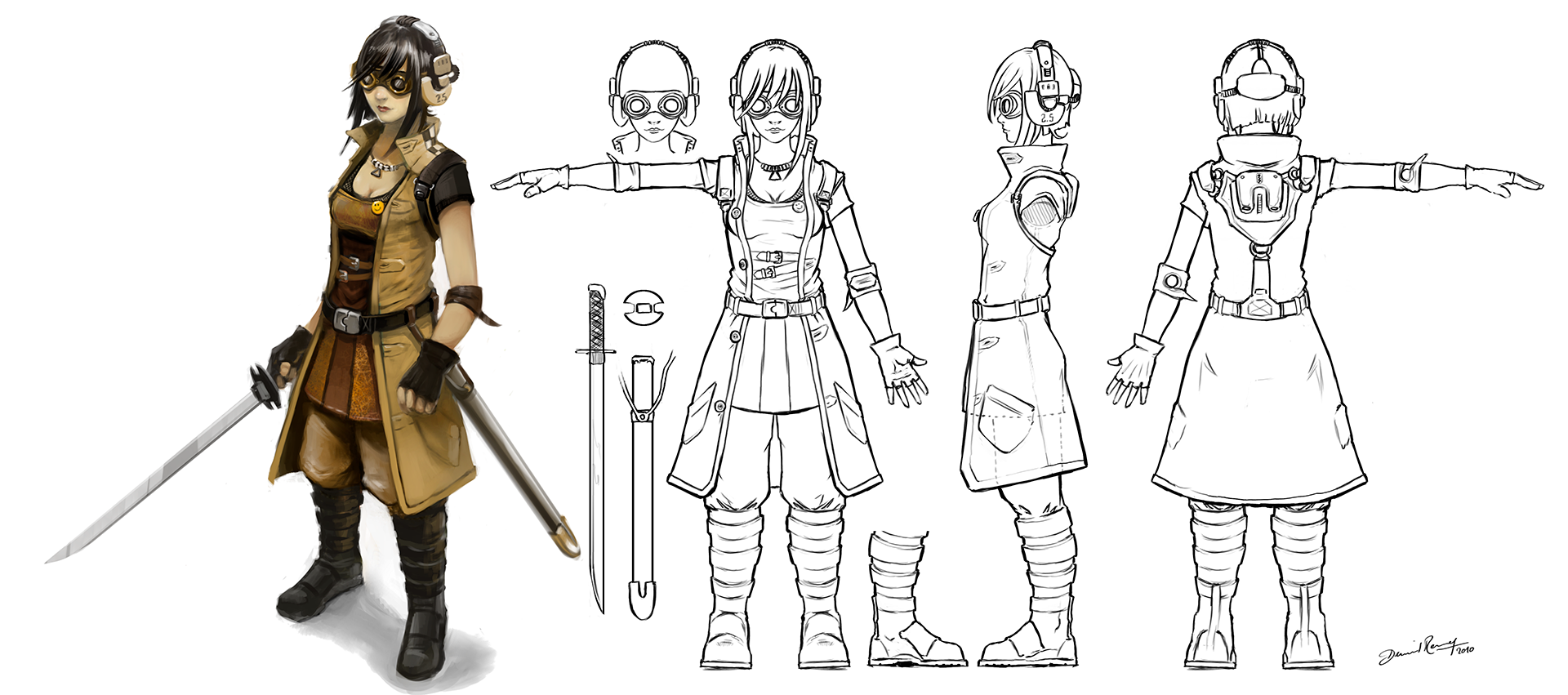
Model sheet character
Here you need to be careful, there are 2 types of them: for animators and for 3D-Schnick . We need one sheet where the figure is strictly in A or T-pose or, as shown in the example, there are several sides (back, front, side) and each side coincides with the other along the lines as in the picture below:
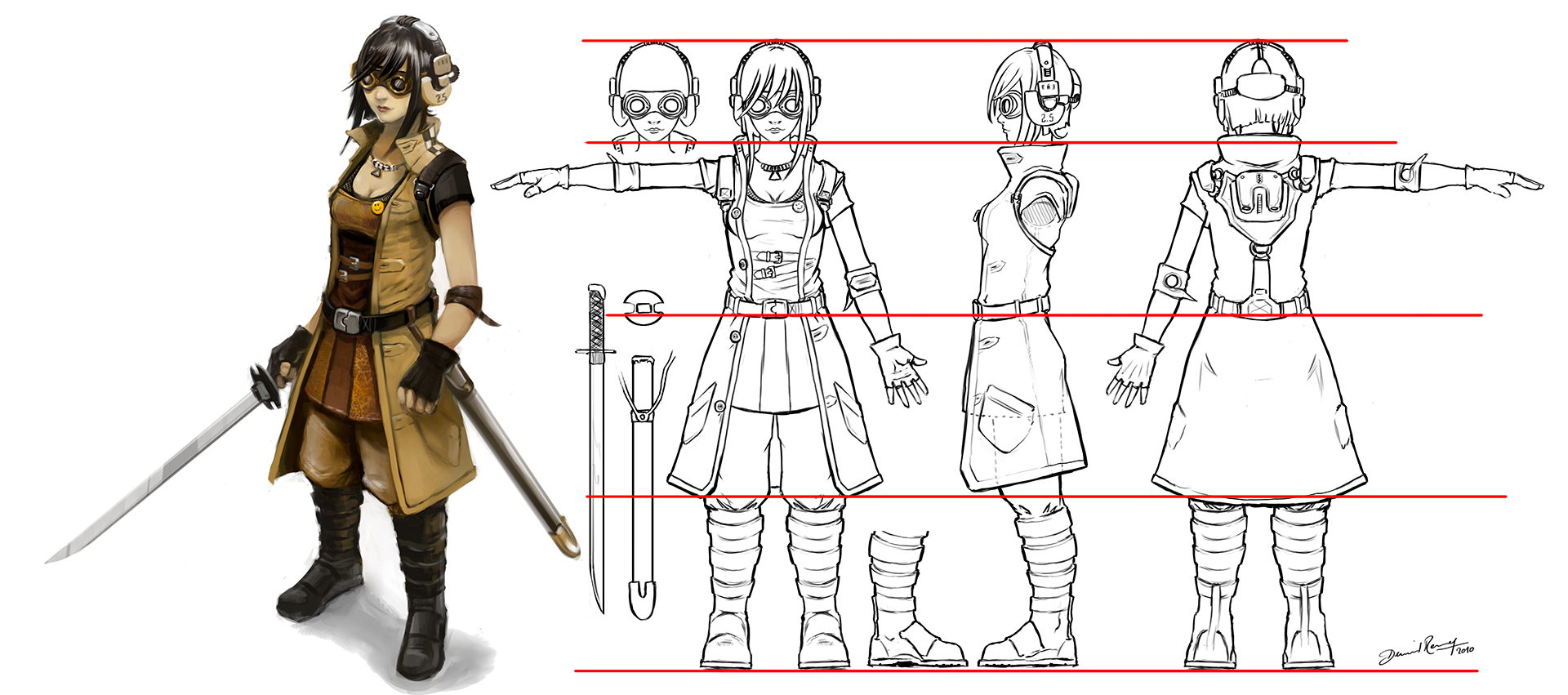
And approximately from this stage divergences begin. Each artist has his own approach to work and depends on the type of modeling, the ultimate goal.
Types of modeling
Since polygonal modeling is most often used in harsh gaming production, we will consider it. There are low- / mid- and high – poly models.
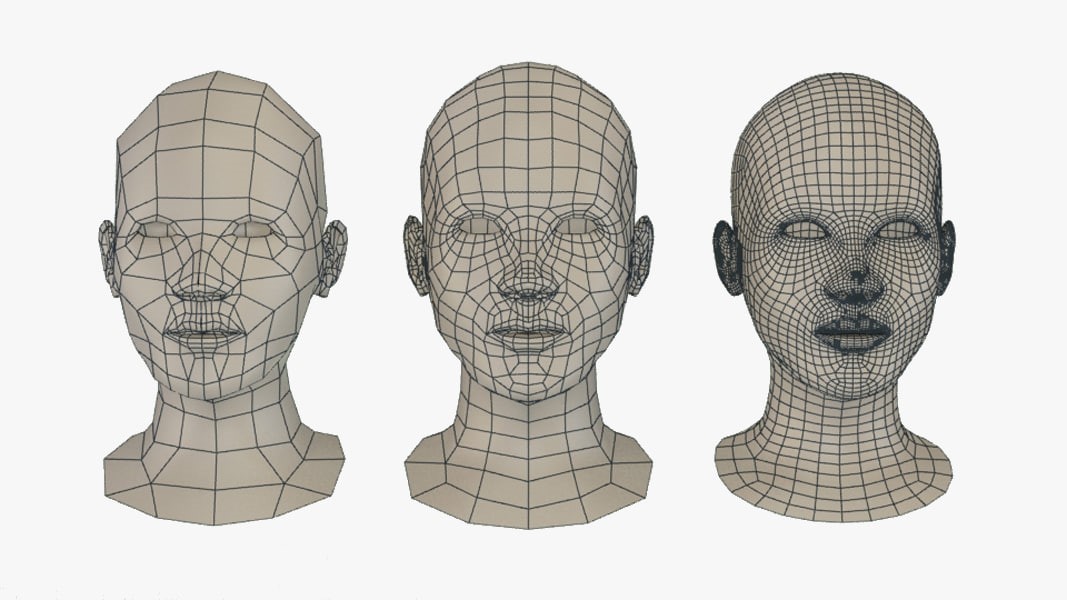
From left to right: low poly, mid poly, high poly
The difference, I think, is clear - the number of polygons and the level of detail. Now, when we understand what model we have to do and with which polygon we work, decide which type it belongs to - hard surface or organic ?
Hard surface example:
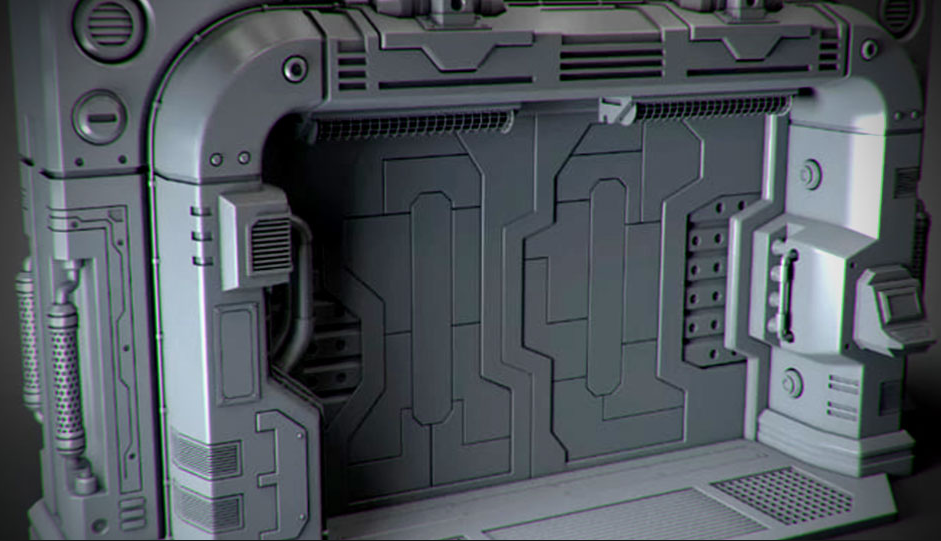
Organic Example:
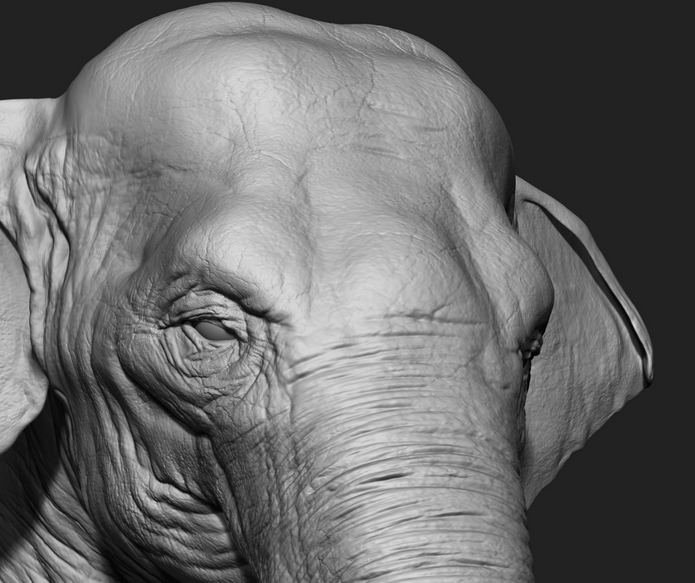
Based on this, we choose the approach, because it is more convenient to use Subdivision modeling for a hard surface, and for sculpting for organics. But, as in any rule, there are also exceptions: in ZBrush you can study the ZModeler tool and make Subdiv or vice versa make organic models without the use of sculpturing (the latter seems to me impractical).
What is subdivision modeling?
Subdivision modeling is a method of representing a smooth surface by smoothing a coarser polygonal mesh.
In fact, you build a grid for anti-aliasing, and then apply the Turbosmooth modifier, which breaks one polygon into four, goes from a primitive to a smooth and complex form. Here's what it looks like:
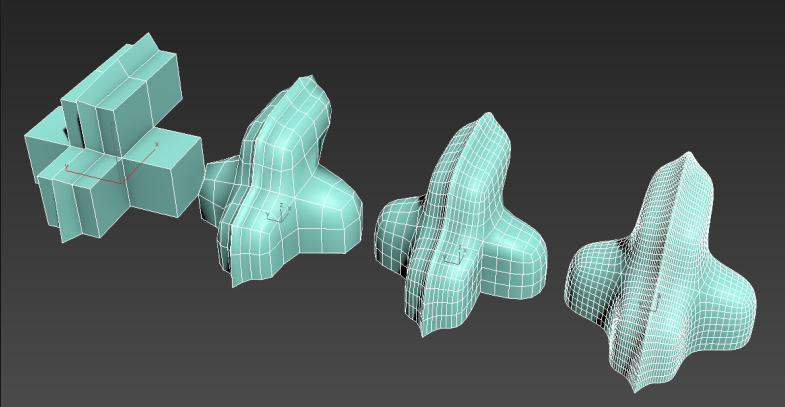
Phased smoothing of rough shape
What is sculpture?
Everyone knows how the sculptor works. Here the principle is the same, you only need to work in a digital environment.
And if you compare the sculpture and Subdiv, the main advantage is that it creates highly detailed objects consisting of millions of polygons, thanks to which the photorealistic quality of the model is achieved, and its main area of application is, of course, the creation of organic models with complex shapes and textures. , copying real, creating fantastic or fairy characters, animals, plants, landscapes and even furniture.
Example:
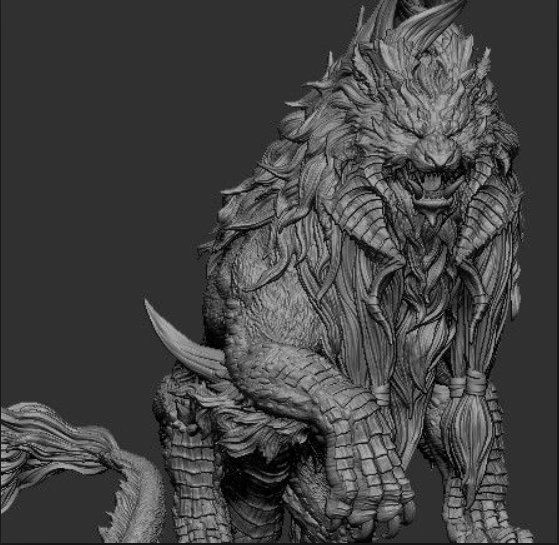
Creating such details with Subdiv is very difficult, almost impossible.
The stages for sculpting and subdiv are different:
Subdiv:
Sculpting (for ZBrush):
Note: it is better to work out the details gradually at each level.
Software: 3ds max, Maya, ZBrush, Blender.
The most difficult stage for a beginner is retopology . This is a whole science, which has its own rules for animation, movies, games.
First, at the current stage, it would be nice to streamline parts of the model, perhaps, to merge some and leave others. For gaming retopology, these elements are usually merged according to the principle “everything that can be separated - separately”.
Consider a more illustrative example:
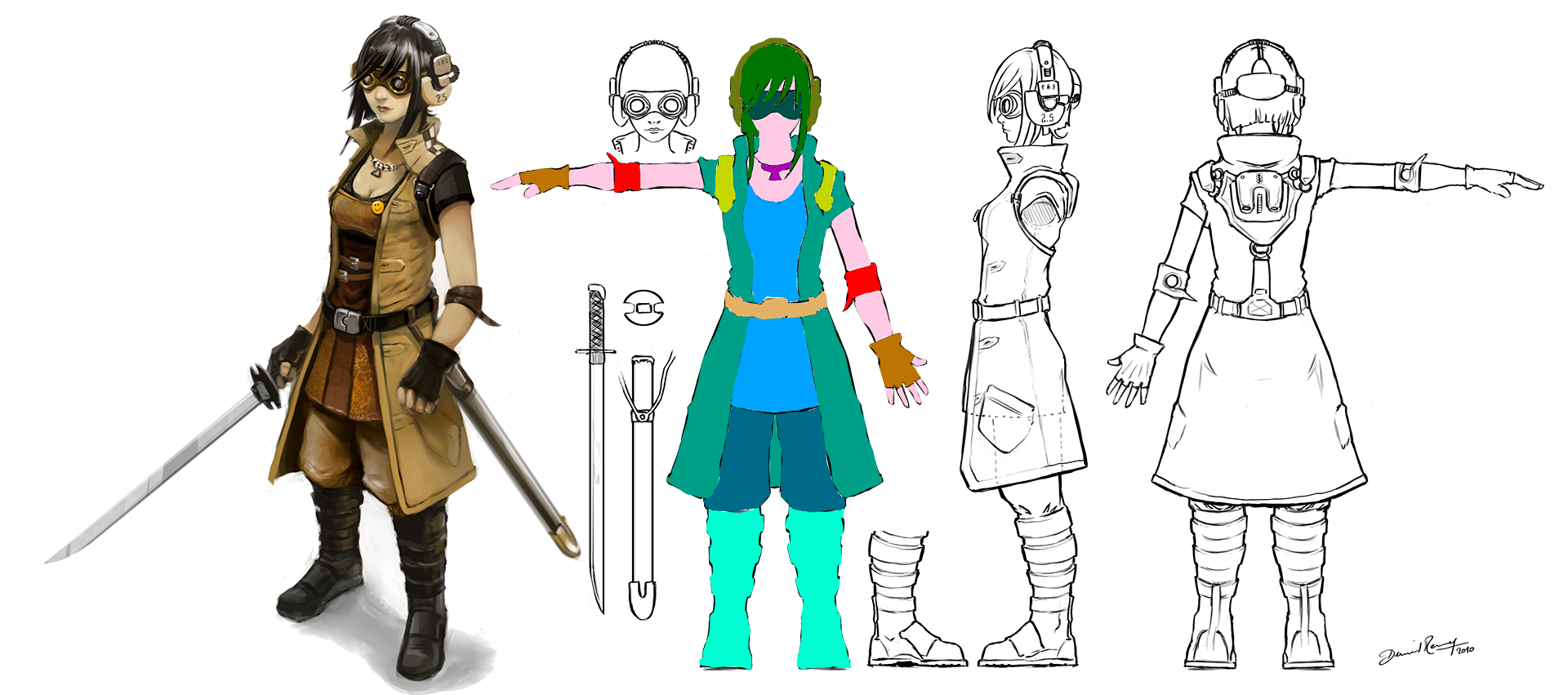
Character divided by Subtulas (highlighted in color)
All that is indicated by one color is one Sabtul.
There are several rules to follow when creating a retopology:
At the moment there are 2 types of retopology: manual and automatic . It’s quite convenient to do the automatic first and then correct the machine’s errors, but the pros still prefer to do it manually.
If the model originally had a Low-Poly version, then the whole retopology is to find a way to make a grid from an existing grid with an even smaller number of polygons. It may be worth removing those parts that are not visible, for example, the body under clothing.
This operation can be performed both in the software in which you modeled and in specialized programs, such as Topogun 2 .
UV is done so that the texture lays down correctly, and not like this:
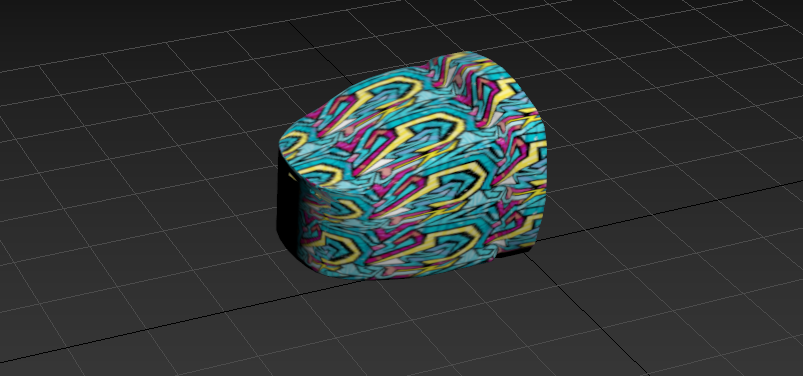
Here is the stretched texture
“UVW scan” or simply “scan” - this is the name that this operation acquired by means of the usual translation from English Unwrap UVW.
Requirements for high-quality scan:
You need to make UV on a low-poly model, in order to bake high-poly parts on it and, in fact, to texture it. At the same time, the low-poly model looks like a high-poly model, but the number of polygons remains the same.
“Bake” means to transfer some characteristics of the material or mesh of the model to the map image. The same principle is used by the artist, when on a flat sheet of paper depicts the volume, color and light.
After the sweep is done, we can look at the results of our labors:

On the left is a scan of the presented model.
The green stripes on the human model are the very seams along which it is deployed.
Now every self-respecting program has the opportunity to do such an operation, there are also specialized ones, such as UVlayout , RizomUV . I have always used the possibilities of 3ds max, quite enough.
Before proceeding to baking textures, it would be nice to do the following:
1. Triangulation of the low-poly model , i.e., split the polygons into triangles, as if the automatic splitting is incorrect, problems with normals (directions of polygons) may appear, which will lead to unnecessary artifacts. But I don’t do that, because modern algorithms in my opinion do a good job with it, and if such problems occur, I go back to this step and fix it;
2. Create a cage . Cage, in simple terms, is a version of a low-poly model that is designed to completely overlap a high-poly one. When built, models should have the same coordinates;
It looks like this:

The blue lattice around the model is cage, the space that will capture the details from the high-poly model
3. Assign each part of the model (in ZBrush - Sabtula) its own material , so that when importing into Substance Painter they are also divided, and not merged together.
Go to texturing.
You can bake the necessary textures in the same program in which you modeled, but I use Substance Painter for these purposes - visually, conveniently, what else is needed.
Baking is done automatically, all you need is to import a scan model (necessarily!) Into the Low-poly program, select the appropriate option, load the high-poly model, select the resolution of the cards, load the Cage, or select indents from the model and click the Bike All button Texture sets.
PBR texturing
The most common PBR gaming texturing technology , Physically-Based Rendering , allows you to create photo-realistic textures using a set of maps.
Frequently used cards:
Here is how it looks on the most primitive example:
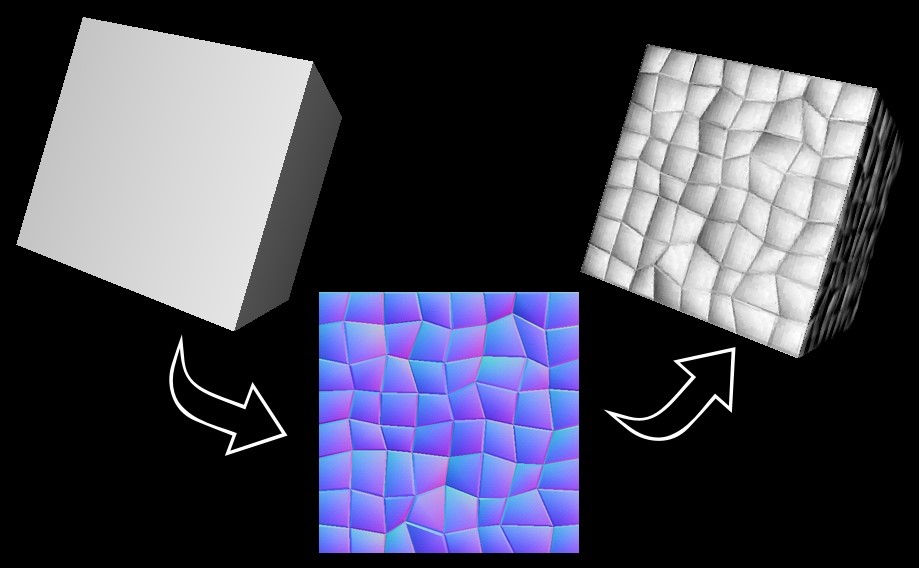
On the left is a square without normal maps, on the right there is a normal map
Substance Painter has a very wide functionality that makes texturing much easier: you can draw directly on the model, use a variety of alphas, ready-made hard surface stamps, procedural maps, filters, masks - in general, a complete expanse for imagination.
After you get the cards that can be exported and sent directly to any game engine, there are many templates: under Unity 4/5, Unreal Engine, Dota 2, V-ray, Corona, and so on.
Actually, this is where the work on the environment ends, the subsequent stages, which will be described in the next article, are used mainly in character creation.
Thanks for reading, may the force be with you!
In this article I will describe the stages of creating models of the environment. Also in the next part we will consider additional stages of work for the artist by characters.
I'll tell you the story of the abstract character Vasya. Something in his life turned upside down, he decided to abandon the good old drawing and move in 3D. Vasya, of course, went to see how much the young luminaries paid for this work and what was required. Opens a vacancy Joon, and there:
- knowledge of 3ds Max / Maya / Blender (it all depends on the desire of the employer);
- skills of low-poly, high-poly, some terrible Subdiv modeling;
- UV mapping;
- PBR texturing;
- knowledge of Substance Painter;
- Photoshop;
- Substance Designer;
- it would still be desirable to be able to visualize the V-ray / Corona / Keyshot;
- the ability to draw by hand;
- someone asks to collect the scene in Marmoset.
And all this is not for some fabulous sums there, but for the average salary of a cashier or waiter (the author
')
Vasya closed the vacancy and cried every evening about the number of scary words and questions in his head.
The end.
In order to reduce the number of broken destinies, I undertake to explain everything.
And the first thing I would like to note - never agree to work for food. There is no need to lower the cost of the work of colleagues in the shop, but also it is not necessary, having done one job, to request millions. When you feel that the level of your work is enough to get money for it,
But while we figure out where to start.
It is necessary to understand that the list of programs required by employers is quite average, with a strong desire, you can do everything in one and get an achive "This guy could, with him the jokes are bad . " But it is still more convenient to use specialized programs, because I will indicate some of them that are appropriate for a particular stage of work.
And so, let's get started.
A brief outline of the article:
- Concept
- Modeling
- Retopology
- UVW Mapping
- Texturing
Concept
The first thing that should be in your head is the concept . You should know exactly what you want to get at the end; I believe that only an experienced person can allow himself to be creative (it is permissible to deviate a little from the concept).
There are several options: you can draw the concept yourself, in order to see what happens in the end, or you can use a ready-made model sheet , of which there are lots on the Internet (just do not forget to get permission from the author, or do it for yourself, do not publish it).
Basically, the model sheet is a concept of characters (both people and animals), but I have even met a model sheet of stone (suddenly). It almost always looks like this:

Model sheet character
Here you need to be careful, there are 2 types of them: for animators and for 3D-Schnick . We need one sheet where the figure is strictly in A or T-pose or, as shown in the example, there are several sides (back, front, side) and each side coincides with the other along the lines as in the picture below:

His Majesty Modeling
And approximately from this stage divergences begin. Each artist has his own approach to work and depends on the type of modeling, the ultimate goal.
Types of modeling
Since polygonal modeling is most often used in harsh gaming production, we will consider it. There are low- / mid- and high – poly models.

From left to right: low poly, mid poly, high poly
The difference, I think, is clear - the number of polygons and the level of detail. Now, when we understand what model we have to do and with which polygon we work, decide which type it belongs to - hard surface or organic ?
Hard surface example:

Organic Example:

Based on this, we choose the approach, because it is more convenient to use Subdivision modeling for a hard surface, and for sculpting for organics. But, as in any rule, there are also exceptions: in ZBrush you can study the ZModeler tool and make Subdiv or vice versa make organic models without the use of sculpturing (the latter seems to me impractical).
What is subdivision modeling?
Subdivision modeling is a method of representing a smooth surface by smoothing a coarser polygonal mesh.
In fact, you build a grid for anti-aliasing, and then apply the Turbosmooth modifier, which breaks one polygon into four, goes from a primitive to a smooth and complex form. Here's what it looks like:

Phased smoothing of rough shape
What is sculpture?
Everyone knows how the sculptor works. Here the principle is the same, you only need to work in a digital environment.
And if you compare the sculpture and Subdiv, the main advantage is that it creates highly detailed objects consisting of millions of polygons, thanks to which the photorealistic quality of the model is achieved, and its main area of application is, of course, the creation of organic models with complex shapes and textures. , copying real, creating fantastic or fairy characters, animals, plants, landscapes and even furniture.
Example:

Creating such details with Subdiv is very difficult, almost impossible.
The stages for sculpting and subdiv are different:
Subdiv:
- building a general shape for a low-poly model;
- at the stage of construction of high-poly smoothing;
- adding small details.
Sculpting (for ZBrush):
- dynamesh blocking
- retopology (at this stage we get low poly, save separately)
- clarifying details by winding up Subdivision levels (works the same as Turbosmooth).
Note: it is better to work out the details gradually at each level.
Software: 3ds max, Maya, ZBrush, Blender.
Retopology
The most difficult stage for a beginner is retopology . This is a whole science, which has its own rules for animation, movies, games.
First, at the current stage, it would be nice to streamline parts of the model, perhaps, to merge some and leave others. For gaming retopology, these elements are usually merged according to the principle “everything that can be separated - separately”.
Consider a more illustrative example:

Character divided by Subtulas (highlighted in color)
All that is indicated by one color is one Sabtul.
There are several rules to follow when creating a retopology:
- in those places where the model will move, it is necessary to make the grid more dense and anatomically correct (build under the natural anatomy);
- no n-gons, only squares, rectangles and triangles, although the latter should be avoided;
- use the minimum number of polygons to describe the form;
- if the square polygon is deformed, it is better to divide it into triangles, draw a diagonal;
- you need to keep a balance in the size of the polygons, they should be about the same and look harmonious;
- it is better to create a grid symmetric, and then edit if the model is asymmetric.
At the moment there are 2 types of retopology: manual and automatic . It’s quite convenient to do the automatic first and then correct the machine’s errors, but the pros still prefer to do it manually.
If the model originally had a Low-Poly version, then the whole retopology is to find a way to make a grid from an existing grid with an even smaller number of polygons. It may be worth removing those parts that are not visible, for example, the body under clothing.
This operation can be performed both in the software in which you modeled and in specialized programs, such as Topogun 2 .
UV mapping
UV is done so that the texture lays down correctly, and not like this:

Here is the stretched texture
“UVW scan” or simply “scan” - this is the name that this operation acquired by means of the usual translation from English Unwrap UVW.
Requirements for high-quality scan:
- when creating a reamer, it is imperative to create seams along which it will unfold;
- It is desirable to hide the seams where the curious player will not get;
- sweep elements need to be distributed within the area given to you (chess square);
- the space of the square should be as full as possible (the larger the size of the part of the scan, the better the texture will be);
- It is desirable to decompose all elements uniquely, but there are cases when some of them can be superimposed on each other (usually called “overlap”) if they are not visible to the player and do not necessarily require uniqueness, for example, the legs of a chair;
- leave some space between the elements to avoid “leakage” to other parts of the map.
You need to make UV on a low-poly model, in order to bake high-poly parts on it and, in fact, to texture it. At the same time, the low-poly model looks like a high-poly model, but the number of polygons remains the same.
“Bake” means to transfer some characteristics of the material or mesh of the model to the map image. The same principle is used by the artist, when on a flat sheet of paper depicts the volume, color and light.
After the sweep is done, we can look at the results of our labors:

On the left is a scan of the presented model.
The green stripes on the human model are the very seams along which it is deployed.
Now every self-respecting program has the opportunity to do such an operation, there are also specialized ones, such as UVlayout , RizomUV . I have always used the possibilities of 3ds max, quite enough.
Before proceeding to baking textures, it would be nice to do the following:
1. Triangulation of the low-poly model , i.e., split the polygons into triangles, as if the automatic splitting is incorrect, problems with normals (directions of polygons) may appear, which will lead to unnecessary artifacts. But I don’t do that, because modern algorithms in my opinion do a good job with it, and if such problems occur, I go back to this step and fix it;
2. Create a cage . Cage, in simple terms, is a version of a low-poly model that is designed to completely overlap a high-poly one. When built, models should have the same coordinates;
It looks like this:

The blue lattice around the model is cage, the space that will capture the details from the high-poly model
3. Assign each part of the model (in ZBrush - Sabtula) its own material , so that when importing into Substance Painter they are also divided, and not merged together.
Go to texturing.
Texturing and Baking Textures
You can bake the necessary textures in the same program in which you modeled, but I use Substance Painter for these purposes - visually, conveniently, what else is needed.
Baking is done automatically, all you need is to import a scan model (necessarily!) Into the Low-poly program, select the appropriate option, load the high-poly model, select the resolution of the cards, load the Cage, or select indents from the model and click the Bike All button Texture sets.
PBR texturing
The most common PBR gaming texturing technology , Physically-Based Rendering , allows you to create photo-realistic textures using a set of maps.
Frequently used cards:
- Ambient Occlusion - shows the interaction between the elements of the model. This map creates soft shading, as if the model is lit without direct light;
- Diffuse - determines the color and image of the object;
- Metallic - shows how metallic the material is;
- Roughness - controls the clarity of light reflections, shows the roughness of the object;
- Normal - is responsible for the relief of the model, each color shows a different axis of direction.
Here is how it looks on the most primitive example:

On the left is a square without normal maps, on the right there is a normal map
Substance Painter has a very wide functionality that makes texturing much easier: you can draw directly on the model, use a variety of alphas, ready-made hard surface stamps, procedural maps, filters, masks - in general, a complete expanse for imagination.
After you get the cards that can be exported and sent directly to any game engine, there are many templates: under Unity 4/5, Unreal Engine, Dota 2, V-ray, Corona, and so on.
Actually, this is where the work on the environment ends, the subsequent stages, which will be described in the next article, are used mainly in character creation.
Thanks for reading, may the force be with you!
Source: https://habr.com/ru/post/455319/
All Articles